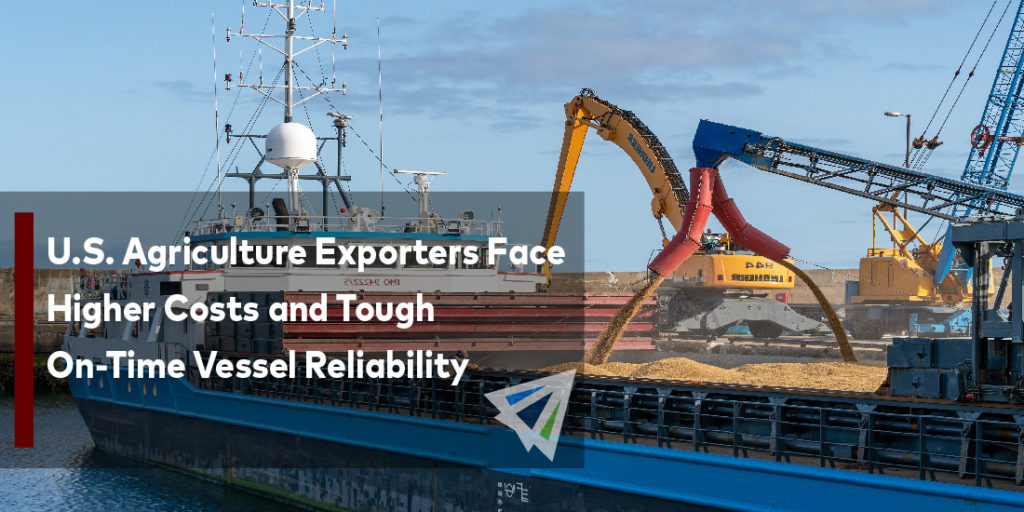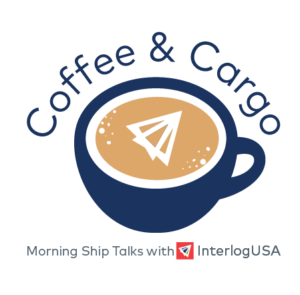Competitive Edge
September 21st, 2022
Stay Current with Interlog’s Weekly Newsletter:


UPDATE: U.S./Canada Ports – Number of Vessels at Anchor as of 09-20-22
- Vancouver: 41 Vessels at Anchor (+3)
- Savannah: 28 Vessels at Anchor (-8)
- Houston: 34 Vessels at Anchor (-2)
- New York/Newark: 16 Vessels at Anchor (-2)
- Mobile: 12 Vessels at Anchor (0)
- Los Angeles/Long Beach: 9 Vessels at Anchor (0)
- San Francisco/Oakland: 5 Vessels at Anchor (0)
- Charleston: 5 Vessels at Anchor (+4)
Takeaways
- U.S. West Coast: Not only is the congestion down, it’s also been consistent with little change week over week. Clearly, the WC is most the stable of the three in respects to vessel congestion.
- U.S. Gulf Coast: Houston remains to be the epicenter of congestion for the Gulf (and the U.S. this week). Mobile has also picked up a sizeable backlog, however both appear to have steadied with no volatile spikes as of late.
- U.S. East Coast: Our week over week counts indicate volatile up and down spikes for Savannah and New York. The EC continues to be at the forefront of vessel congestion.
Note: This count does not include vessels moored and being unloaded at port docks. Colored numbers in parentheses represents the change from last week over.
Courtesy: MarineTraffic
IMPORT: Asia to North America (TPEB)
Recent Developments:
- China’s Golden Week begins October 1 through October 7. Factories in China are closed during this time. Typically, demand and volumes from U.S. importers surge in the weeks leading up to the holiday, but so far, they have not.
- U.S. port congestion and intermodal delays remain contributing to unreliable scheduling.
- Contract negotiations between the International Longshore and Warehouse Union (ILWU) and Pacific Maritime Association (PMA) remain active. The existing labor contract between the two parties expired July 1.
- Blank sailings are becoming more commonplace as carriers aim to cut down on port congestion, especially on USEC.
- For Canada, vessel calls to Vancouver continue to face significant delays, partly due to terminal congestion but also due to delays departing Asia.
Rates: Rates remain low, but have settled, from Asia to the U.S. coasts.
Space: Space is generally open at this time.
Capacity: Capacity has tightened in pockets. Shippers continue to divert cargo to the USEC and USGC due to fears of disruptions at West Coast ports from ongoing labor talks.
Equipment: Some inland terminals are reaching max capacity with inventory. Intermodal systems remain stressed with congestion and truck and chassis deficits.
TIPS:
- Book at least two weeks prior to the ready date.
- For cargo ready now, take advantage of opening space and fallen rates on the spot market.
- Reconsider averting West Coast routings. The “hot spots” for ship congestion and vessel wait times has shifted to the East Coast.
Our experts touched base on China’s Golden Week holiday and its impacts on the shipping industry in our Interlog Insights Newsletter!
IMPORT: Europe to North America (TAWB)
Recent Developments:
- Northern European hubs, such as Rotterdam, Antwerp, and Hamburg, remain critically congested.
- Labor-related tensions have gripped the U.K.
- Some 560 dockworkers at Britain’s Port of Liverpool have begun their strike in a dispute over pay and will continue until October 3.
- Meanwhile, Britain’s largest container port, Felixstowe, is planning a second round of strikes to a similar rejection of a pay deal. The next strikes could start as soon as September 27. 2,000 workers at the port had an eight-day walkout in August.
- USWC ports have seen port and yard congestion and improvements to vessel waiting times.
- Canada has had challenges with rail yard congestion. Prince Rupert stands out as import dwells times have shot up as inconsistent railcar supply hampers the port.
- On the USEC, both ports of New York/Newark and Savannah remain having a significant number of backlogged vessels at anchor off their respective shores.
- The Port of Houston, on the U.S. Gulf Coast, is also grappling with vessel congestion.
Rates: Rates remain elevated but are holding steady for the foreseeable future.
Space: Space remains critical to the USEC. However, space has opened for direct routings to the USWC.
Capacity: Capacity for both North Europe and Mediterranean services remain gripped. Low water level of Germany’s Rhine River continues and both terminals experience a shift from barge to truck capacity for import and export delivery/pick-up.
Equipment: Equipment at European seaports is not as readily available as it has been for the past few months. Inland terminals in Europe are also still reporting equipment shortages. On the U.S. side, truck and chassis availability remain concerning, especially with the latter.
TIPS:
- Book five or more weeks prior to ready date.
- Strongly consider premium services for no-roll options and improved reliability of cargo.
- Be flexible and entertain alternative routings. They could cut back on wait times.
EXPORT: North America to Asia
Recent Developments:
- Shanghai, Ningbo, and Qingdao are among the larger Chinese ports affected by September’s Typhoon Hinnamnor. The storm system, which hit earlier in the month, has spurred on delays and waiting times after port and terminal services closed Sep. 4 to Sep. 6.
- For the USEC, port congestion remains an issue for Savannah and New York/Newark.
- Diminished schedule integrity continues to challenge post earliest return dates.
- Vessel arrivals remain smooth for USWC POLs.
Rates: So far, no GRIs announced for September.
Capacity: Available capacity remains fluid for USWC POLs.
Equipment: Truck, container, and chassis availability remains dire and has significantly contributed to congestion of the intermodal system and IPI origins. Standard equipment at ports remains available unless carriers advise otherwise.
TIPS:
- Book four to five weeks prior to the time of departure to secure necessary equipment and vessel space.
Did You Know: A Tentative Agreement has been Reached Between the Union Representing Security Guards at the Ports of LA/LB
First thing to note about this is, this is separate from the current dockworker contraction out on the West Coast that is currently still in negotiations.
The ILWU Local 26 and Pacific Maritime Association will finalize the details of the tentative deal after the current dockworker contract negotiations have concluded
Source: Journal of Commerce
Freight News
Port of Liverpool two-week strike begins
Members of the Unite union at the Port of Liverpool have started their two-week strike that is scheduled to go until October 3rd. The union says more than 560 port operatives and engineers will take part in the strike, reports show.
The group that operates the port said the workers rejected a “significant pay package” that included an 8.3% rise and a one-time payment of £750, or around $856, Maritime-Executive reports. The union continues to ask for an increase in base pay around 12.3 percent. The port also has made changes in the work shifts for the dockworkers, specifically a 25 percent reduction in night shift work.
Now, some experts feel that peak cargo season from China to Europe could be delayed because of the Port strike in Liverpool, as well as the looming second port strike in Felixstowe, that is set to begin on September 27th. Golden Week in China takes place from October 1st-7th, during which factories are shut down and resume after the holiday. In prior years, many shippers try to get their containers ahead of Golden Week in China, because of the factories shutting down.
One area that CNBC is seeing delays is order lead time to the customer. Since production part availability issues, labor issues, truck delays, on top of the port delays that are occurring, some cases are seeing end-to-end transit time possibly increases from 15-30 days to 20-45 days, reports show.
Will the empty container congestion at ports improve in 2023?
Empty container congestion at ports has been a significant issue for almost a year now, with many blaming that issue as part of the reason for the backlogs and disruption to the supply chains.
Some ports around the U.S., like the Port of LA/LB and the Port of New York/New Jersey, and others, have threatened to implement container dwell fees because of the excess dwell times the ports have been experiencing.
It’s hard to say whether the empty container congestion at ports will improve by the start of next year. However, there is optimism that it’s less bleak than what it has been this year. For instance, data from Sea-Intelligence has shown that IF transportation time goes back to a new normal by early 2023, there could be a release of over four million TEU’s of excess containers in North America.
The reason this empty container congestion got to be so significant was during the peak surge in shipping volumes, containers got caught up in longer supply chains… that then created a huge shortage of empty containers, and carriers had to order new containers that were manufactured in Asia, Maritime-Executive reports. The hope is that as things become to their new normal, the additional containers will be back out in the supply chain.
Blog Of The Week

U.S. Agriculture Exporters Face Higher Costs and Tough On-Time Vessel Reliability
Watch Today's Webinar and Sign Up for Next Month's!

Take a look at today’s webinar where we discussed a variety of topics including:
-Recap of Summer: rates dropped and space opened up
-How to prepare for the upcoming Golden Week in China
-Managing demurrage and detention
-Current events
-Live Q&A!
If you would like to sign up for our next webinar in October, please make sure to click the sign up button below!
Sign up for our
industry answers
Our team works to provide valuable, unique, and relevant content to assist you in finding solutions. Sign up now.
